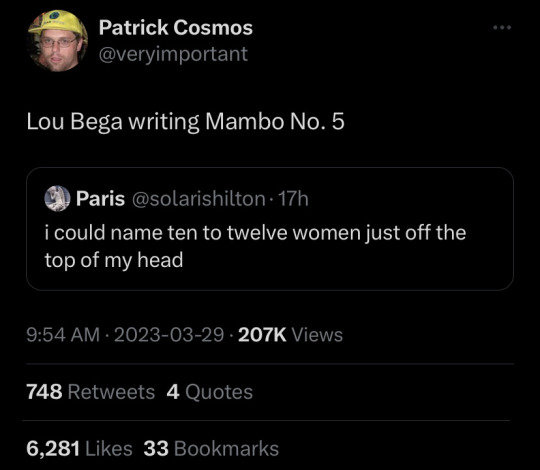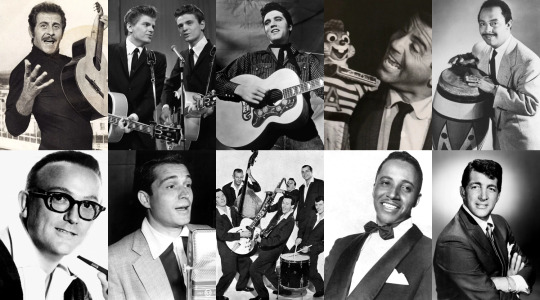#Perez Prado
Explore tagged Tumblr posts
Text

Cuban pianist, bandleader, and composer Pérez Prado was #botd in 1916. Known as “The King of the Mambo” for popularized the mambo in the 1950s.
83 notes
·
View notes
Text

Perez Prado - A Cat In Latin, 1964.
59 notes
·
View notes
Photo

10:35 AM EDT August 12, 2024:
Perez Prado - "Goldfinger" From the album Music To Read James Bond By (August 1, 1968)
Last song scrobbled from iTunes at Last.fm
8 notes
·
View notes
Text
Elizabeth Punsalan and Jerod Swallow 1996 Free Dance “Rhumba + Cha Cha”
Quizás, Quizás, Quizás by Perez Prado.
#the serrated edge of her skirt! fab.#something about jerod is so hot & it’s not bc he looks like benicio del toro. it’s the way he skates and shows liz off.#ice dance#elizabeth punsalan#jerod swallow#figure skating#perez prado#serrated hem
47 notes
·
View notes
Text
Doc Cheatham: A Life in Jazz
Introduction: Adolphus “Doc” Cheatham was a master of the trumpet whose career spanned over seven decades. During this extensive period, he collaborated with some of the most influential figures in jazz, and his unwavering dedication to his craft left an indelible mark on the genre. In this blog post, we delve into the life and legacy of Doc Cheatham, exploring his early beginnings, major…

View On WordPress
#Albert Wynn#Benny Carter#Bobby Lee#Cab Calloway#Chick Webb#Claude Hopkins#Doc Cheatham#Doc Cheatham & Nicholas Payton#Fletcher Henderson#Jazz History#Jazz Trumpeters#Louis Armstrong#Ma Rainey#Machito#Marcelino Guerra#Marion Handy#McKinney&039;s Cotton Pickers#Nicholas Payton#Perez Prado#Ricardo Ray#Sam Wooding#Teddy Wilson#Wilbur de Paris
3 notes
·
View notes
Text
Year-End Poll #6: 1955

The sound of a decade does not change the minute the ball drops on New Year's Eve. With the benefit of hindsight, it's easier to form these cultural shifts into a narrative, even when said shifts aren't always obvious. 1955 offers us the music we've grown accustomed to over the course of this decade: traditional pop, vocal quartets, jazz standards. However, this year also gives me an opportunity to highlight some different genres that will come to shape the decade in the years to come.
The post-war 1950s saw a boom in popularity when it came to music from South and Central America. We saw this before with the inclusion of other Spanish language songs reaching the Top 30, but artists like Pérez Prado and later Ritchie Valens helped to popularize Latin music in the States. Pérez Prado is, of course, known for popularizing mambo, a Cuban genre of dance music, by incorporating big band influence. The Prado song featured on this poll is not mambo, but rather one of its descendants, cha-cha.
In 1955 year-end chart, we're seeing the first traces of a genre of music that will help define the decade's sound: rock and roll. With the inclusion of Bill Haley's Rock Around the Clock, we're seeing the first rock and roll song to top the Billboard charts. Obviously, rock and roll has existed long before Bill Haley and Pat Boone reached the top 10. Unfortunately, like many other historically Black genres, white faces typically sold better with mainstream audiences. Is this the last we'll see of record executives using white performers to market Black music to white audiences?
Foreshadowing is a literary device--
More information about this blog here
#billboard music#billboard poll#1950s music#music poll#perez prado#bill haley#mitch miller#roger williams#les baxter#bill hayes#the four aces#the mcguire sisters#pat boone#georgia gibbs
29 notes
·
View notes
Video
youtube
Perez Prado - Cherry Pink and Apple Blossom White (slowed+reverb)
7 notes
·
View notes
Text
Flashback: Mambo No. 5 - Lou Bega
30th September 2024
'Die With A Smile' is still #1 (for the sixth week now!), so we'll flashback twenty-five years to 1999 when the #1 song was the incredible 'Mambo #5' by Lou Bega.
youtube
Is it a slightly annoying song? Yes, 100% But now that we're not in 1999 anymore, and 'Mambo No. 5' isn't getting overplayed on the radio, I think we can all agree that it's also really fun and maybe secretly kinda great. But, speaking as a 90's kid, there was definitely a while where it earwormed it's way into everyone's brains and drove us all crazy.
I was surprised to find out that Lou Bega's version of 'Mambo No. 5' is actually a cover! The original is an instrumental jazz-mambo song by Perez Prado (who was also known as the King of the Mambo) back in 1949. It's also kinda great, and you can see why Lou Bega built his version off of the original.
youtube
Bega's 'Mambo No. 5' hit the #1 spot on the charts in basically every country. Seriously! Take a look at this. It's crazy, and I actually haven't seen another song that's done this (although I'm sure there are others out there).

Apparently America were not willing to jump on the same bandwagon as the rest of the world though! The #1 there was Santana and Rob Thomas' (from Matchbox Twenty) 'Smooth' which weirdly only got to #18 in NZ.
'Mambo No. 5' was Bega's only major hit, so he was essentially a one-hit-wonder. He is still making music though, with his most recent album released in 2021.
That's it for now. See you next week when we'll see if Lady Gaga and Bruno Mars can achieve a seventh straight week at #1.
0 notes
Text
Perez Prado supremacy
youtube

1K notes
·
View notes
Text
0 notes
Text

Ferdinand the Catholic
Artist: Bernardino Montañes y Perez (Spanish, 1825-1893_
Date: c. 1848
Medium: Oil on canvas
Collection: Museo del Prado, Madrid, Spain
Ferdinand II of Aragon
Ferdinand II (10 March 1452 – 23 January 1516), called Ferdinand the Catholic, was King of Aragon from 1479 until his death in 1516. As the husband and co-ruler of Queen Isabella I of Castile, he was also King of Castile from 1475 to 1504 (as Ferdinand V). He reigned jointly with Isabella over a dynastically unified Spain; together they are known as the Catholic Monarchs. Ferdinand is considered the de facto first king of Spain, and was described as such during his reign, even though, legally, Castile and Aragon remained two separate kingdoms until they were formally united by the Nueva Planta decrees issued between 1707 and 1716.
#portrait#fine art#painting#oil on canvas#ferdinand the catholic#spanish monarchy#spanish history#ferdinand ii of aragon#king of castille#catholic monarch#king of spain#full length#interior#standing#bernardino montanes y perez#spanish painter#spanish culture#royal robes#crown#specter#oil painting#19th century painting#european art#19th century art
25 notes
·
View notes
Photo

3:51 PM EST February 16, 2023:
Perez Prado - "Goldfinger" From the album Music To Read James Bond By (August 1, 1968)
Last song scrobbled from iTunes at Last.fm
2 notes
·
View notes
Text

A peak at the holiday cocktail party of yore... clinking glasses, murmurs of mirth, a faint scent of Arpege perfume and somewhere there's a 78 rpm record playing Mambo No. 5 by Perez Prado.
55 notes
·
View notes
Text
SET EIGHT - ROUND TWO - MATCH FOUR


"Carroña" (2011 - Javier Perez) / "The Dog" (1819–23 - Francisco Goya)
CARROÑA: The description I found at the Cornish Museum of Glass' website for this piece states that it is inspired by the loss of traditional glassmaking in Italy, which fits very well with the red glass chandelier. Obviously, it is glass, but the chandelier pieces also resemble bones, organs, and other recognizable, natural shapes rendered in shiny red glass as if made of perpetually-fresh blood. It is made to represent an animal, and I would like to argue that this animal is human. The very human urge to create and own things that are nice is combined with the reliance an artist has on the customers' enjoyment of the art - the chandelier represents the humans who were a part of the glassmaking industry, or even enjoyed it, and their culture is here, being consumed.
That brings us to the birds, the crows eating a corpse. But the crows are not necessarily guilty of killing this chandelier; the glass sprays as if it fell. The crows may or may not have pecked it from its ceiling, but they are certainly enjoying the spoils. The crows are eating the chandelier, and if the chandelier is humans and culture, what are the crows? Are they merely the representation of the way of life - the energy of the food - being changed into another form, like the people who would have learnt the trade or those no longer capable of making a living off of it moving on? Or did they indeed commit the crime they are feeding off of, and are other markets or businesses come to take profitable pieces of the chandelier?
Also, c'mon, it's crows eating a cool-looking chandelier. That's pretty metal, if you ask me. (grinning-reaper-black-pearl)
THE DOG: I saw Goya's dog in the Prado years ago, and it struck me with such dread and sadness. The whole gallery with his "black paintings" was an incredibly intense and uncomfortable experience -- you can really feel the dark emotions in these pieces. I think I actually cried looking at this one -- the dog is so helpless, just a little island in all the negative space. (ladycoriolanus)
(Carroña is a sculpture by Javier Pérez made with murano glass and stuffed crows. It measures 120 x 235 x 300 cm (47 x 92.5 x 118 in).
“The Dog” is an painting by Francisco Goya, that was originally painted on the plaster walls of his house and later transferred onto canvas. It measures 131.5 cm × 79.3 cm (51+3⁄4 in × 31+1⁄4 in) and is located in the Museo del Prado in Madrid.)
#art that fucks you up tournament#polls#atfyu polls#id in alt text#cw blood#the doggo again suffers for tumblr cropping
90 notes
·
View notes
Text
Year-End Poll #9: 1958

More information about this blog here
Now that we're reaching the end of the decade, we're seeing the culmination of the rising trends coming together in the charts. Traditional pop, early rock and roll, Latin pop, and the novelty song. Even going beyond the genres themselves, 1958 also marks a shift regarding the business side of the music industry. In August of this year, the Billboard Hot 100 was officially implemented, but we won't see the effects of that until next year. The 1950s serves as a fascinating transitional period in music culture.
And just to make things more complicated, some versions of the 1958 year-end chart feature both the A-sides and B-sides of some of the songs. I wondered if it had something to do with the introduction of the Hot 100, or perhaps because the B-sides charted equally or higher on different charts. But I have nothing to base that hypothesis off of and my own research hasn't helped me find anything. I reached out on the Billboard subreddit for help and a user named jdeeth was kind enough to give me a more thorough explanation. To make a long story short: in addition to the implementation of the Hot 100, 1958 was also the year Billboard started listing two-sided hits as a single entry, but this practice didn't catch on. However, there are future entries where two-sided hits are listed simultaneously again, but under different circumstances so I'll cross that bridge when it comes up.
#billboard poll#billboard music#tumblr poll#music poll#1950s music#1958#1950s#domenico modugno#the everly brothers#elvis presley#david seville#alvin and the chipmunks#perez prado#billy vaughn#perry como#the champs#tommy edwards#dean martin
28 notes
·
View notes
